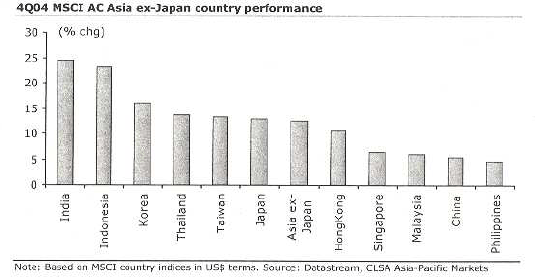Kuroto Fund, L.P. - Q4 2004 Letter
Dear Partners and Friends,
Performance
In the fourth quarter, Indonesia, India and Korea, the three countries in which we have the largest exposure, were Asia’s best performing markets. We want to reassure our investors that this happy result was completely serendipitous and not a product of brilliant top-down market selection. (“The gods favor children and fools.”)
Kuroto’s Hard Close
Since closing to new investors in September of 2004, Kuroto has received a surprising amount of additional capital from existing clients, one hundred and four million dollars to be exact. This additional capital, in combination with the fund’s appreciation over the past nine months, has pushed total partnership capital over the three hundred million dollar mark. Accordingly, we have decided to hard close. Capital inflows on April 1st and July 1st will be rationed. Following our opening on July 1st,we will stop accepting additional capital entirely.
Tsunami Relief
Kuroto Fund’s general and limited partners donated almost $100,000 to the Kuroto Asian Disaster Relief Project with the American Red Cross. These funds have been earmarked for emergency water supplies for the hard hit Aceh region on the Indonesian . We want to thank those of you who generously supported our effort to help the victims of this unprecedented natural disaster.
Risk/Reward of Asian Equities
A thoroughly parochial American view of investing in foreign markets was recently evinced by a well-known Wall Street strategist. She maintains that the ownership of emerging market equities is currently more risky than the ownership of domestic ones:
“It’s interesting. You worry about speculative stocks going up, and yet you’d rather invest in countries where you can’t know the economy. You can’t know the politics. You can’t know the possibilities of terrorism. You can’t know the currencies. I don’t see the consistency there in terms o friskiness.” Fortune Magazine December 27, 2004 p. 109 What’s Ahead for 2005 Roundtable Interview
Kuroto respectfully disagrees with this appraisal. We hav elong argued that investing in Asia, while requiring a stout heart and a long-term investment horizon to weather the occasional market swoon, is not inherently more “risky” than investing in the States. In fact from our perspective, ’s stocks are currently much less “risky” than their American counterparts. For starters, the types of superior businesses in which we invest continue to trade at low valuations in while their American counterparts continue to trade at very high valuations. Asia’s region-wide under- appreciation of the best businesses has allowed us the unusual option of maintaining our value discipline while concentrating our portfolio in companies with monopolistic returns on capital and predictable growing streams of free cash flow. While Asia’s currencies do add an additional degree of volatility to our returns, over time this volatility quite clearly represents a huge long-term profit opportunity, not a risk factor.
Not believing that our holdings in are particularly “risky,” we have never felt compelled to run a tightly hedged portfolio there. (The bulk of our current short exposure is designed to protect our portfolio against region-wide interest rate increases.) It appears that others are gradually beginning to concur with us on this issue:
“[in Europe] there is the growing belief in the view…that it makes much more sense to invest in ex-Japan on along-only basis. This changing perception may in part reflect the fact that Asian stock markets have been rising and, thus, long-only is doing better. But it also reflects awareness that volatility is inevitable when investing in and emerging markets, and that it nearly always makes sense to invest more money on sudden breaks down. The market reaction to last year’s Indian election provided a salutary lesson for many in this respect. There is also awareness that it is difficult, as well as risky, to short in .” Chris Wood, CLSA Fear &Greed
While volatility is not the same as risk, it is important to realize that Asian capital market share prone to bouts of manic enthusiasm and pessimism. At the moment, enthusiasm for stocks is growing region-wide. That said, the current low valuations of Kuroto’s long positions (nine times 2005 “look through” earnings) suggest that Asian equity markets are not yet expensive and that we have yet to reach a worrisome level of enthusiasm. When we cannot identify cheap Asian stocks, we will no longer invest there. In the meantime, we expect to profit from our superior businesses’ earnings progress and regional currency appreciation.
Sincerely,
Sean Fieler
William W. Strong










